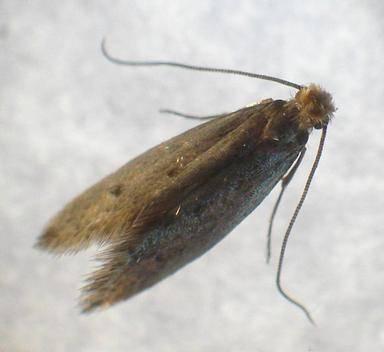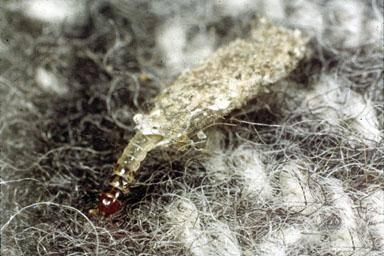Key points
-
Carpet beetles or Indian meal moths are usually more common in homes than clothes moths.
-
Soiled woolens are the primary food of clothes moth larvae (the adult moth does not feed but reproduces). They cannot complete development on clean wool since they require certain vitamins present only in stained or soiled fabrics.
-
The most effective control measure is prevention. Clean, properly stored woolens are not attractive to fabric pests.

Webbing clothes moth (Tineola bisselliella). Photo: Mohammed El Damir, Bugwood.org
Webbing and casemaker clothes moths
-
Both the casemaking and the webbing clothes moths occur in Maryland. The adults of both are tiny (1/2 inch wingspan), yellowish, with narrow wings fringed with long hairs.
-
The larvae are small, white caterpillars with brown heads.
-
They feed on the surface of the infested material.
-
The webbing clothes moth larva does not live inside a case but instead spins silk tubes over the feeding surface and often hides and feeds in these attached tubes.
-
The casemaking clothes moth larva is rarely seen, however, since it constructs a cylindrical case of fabric that it carries around to hide and feed in. The color of the threads in the larva’s case will help you locate the infested material.

Casemaking clothes moth (Tinea pellionella). Photo: Mohammed El Damir, Bugwood.org

Casemaking clothes moth (Tinea pellionella) larva. Photo: Clemson University - USDA Cooperative Extension Slide Series , Bugwood.org
Management
-
The most effective control measure is prevention.
-
Dry cleaning alone will kill all stages of clothes moths but gives no protection against reinfestation.
-
Hand washing with a mild soap for woolens should also kill the insects.
-
Woolen articles should be cleaned and stored in sealed boxes. Cedar chests, blocks, or closets also provide protection. Old clothes, blankets, furs, etc. no longer in use and stored for long periods of time may harbor infestations of clothes moths. They should be periodically inspected and protected or removed.
-
Check underneath wool rugs for larvae. Vacuum or shampoo infested rugs.
-
Mothballs or flakes should be used as a last resort and only in sealed containers. Use only moth balls or flakes containing naphthalene (vapors can produce toxic reactions in sensitive individuals). Naphthalene works as a fumigant to kill insects. It is not effective as a repellant.
-
Avoid the use of mothballs or flakes made of paradichlorobenzene, or PDB. Paradichlorobenzene is more toxic than naphthalene and has been implicated as a human carcinogen (cancer-causing agent).
Rev. 2020
